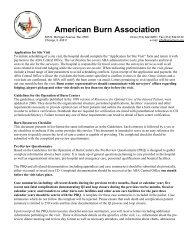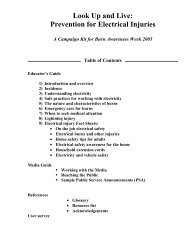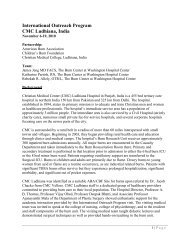Electrical Safety Educator's Guide - American Burn Association
Electrical Safety Educator's Guide - American Burn Association
Electrical Safety Educator's Guide - American Burn Association
Create successful ePaper yourself
Turn your PDF publications into a flip-book with our unique Google optimized e-Paper software.
GENERAL BACKGROUND INFORMATIONOur lives are dependent on electricity, 24 hours a day. It is such an important part of our dayto day living that it is almost impossible to fathom a world without electricity. Even while wesleep, electricity is keeping our food cold and our security systems operating. Throughout theday, throughout the year, we tend to take electricity for granted. However, as fire andemergency service workers and burn care professionals, we see the results, often devastating,when electricity escapes its insulation or is taken for granted at the wrong time and place. Theinformation in this campaign is designed to stimulate awareness of how electricity works,travels and is used, to help reduce its danger as a powerful force that can result in fire, injuryand death.In the United States, on average 400 die from electrocution and 4,400 are injured each yearbecause of electrical hazards. Of these, 180 are related to consumer products. Another 325 dieand 4,000 are injured in workplace electrical accidents, according to data published by theNational <strong>Safety</strong> Council. Electricity also causes over 140,000 fires each year, resulting in anadditional 400 deaths, 4,000 injuries and $1.6 billion in property damage. Total economiclosses due to electrical hazards are estimated to exceed $4 billion annually. 1The age distribution of electrocutions is bimodal; the first peak occurring in early childhood(below age 6) and the second in young adulthood. Most electrocution deaths in adults in adultsare work-related, and electrocution is a frequent cause of occupation-related death. 2The most severely injured victims of contact with electricity are treated in the nation’s 125specialized burn care facilities. According to the most recent (2005) report of the <strong>American</strong><strong>Burn</strong> <strong>Association</strong>’s National <strong>Burn</strong> Repository, 4.3% of the patients admitted to these facilitieshad suffered electrical burn injuries, 3 or about 1,100 patients a year. Many of these patientslose limbs or experience long-lasting damage to nerves, muscles and internal organs. Manythousand others are treated in hospital emergency departments.Lightning, a naturally occurring manifestation of electricity, is responsible for up to 100 deathsa year, according to the National Oceanic and Atmospheric Administration. With the recentexception of the year 2005, when Hurricane Katrina killed an estimated 1,200 people, lightingnormally results in the highest annual fatality total of any natural hazard in the United States.<strong>Electrical</strong> injuries are on the increase world-wide, as access to electricity increases in areaswhere less protection from its hazards may be in place than in more developed countries. Inreports from Turkey and the Dominican Republic, electrical injuries comprised a much higherproportion of burn center admissions than in the U.S.1. Data in this paragraph published by <strong>Electrical</strong> <strong>Safety</strong> Foundation International, 2006.2. “Electrocution and Life-threatening <strong>Electrical</strong> Injuries “, C. Spies and R. Trohman, Annals of Internal Medicine2006; 145:531-5373. National <strong>Burn</strong> Repository 2005 Report, <strong>American</strong> <strong>Burn</strong> <strong>Association</strong>, Chicago, ILUnderstanding electricity• Although electricity is invisible, odorless and has no shape or form, the earth’sCommunity Fire & <strong>Burn</strong> Prevention Programs<strong>Electrical</strong> <strong>Safety</strong> Campaign
















